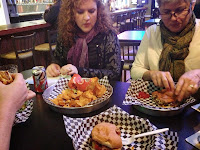Third Base Brewery - Cedar Rapids, IA

Third base brewery and pub is located on the north side of Cedar Rapids in the industrial area and is a storefront in a small strip mall. Not much to recommend it until you come in and enjoy the food and the wing. Great beer, some outstanding wings with many of the sauces including their own beers. Kate and I enjoyed this pub with her Brother Bill Crowley and his wife Mary. Good sandwiches and what a sampler! Best of all, the beers were all good. These were my notes - my scales are these - first 1 - 5 light to dark, second 1 - 5 sweet to bitter (think malt to hops), and third how much I like it from 1 - 10. For an example think Bud, Miller and those other poor examples of beer would be around a 1 - 2 - 3. Anything over 5 is worth drinking - 5 means easy to drink - nothing outstanding, 6 would be a nice beer with some good attributes, 7 is a beer I would order again, 8 is outstanding and over 9 is on the way to perfection. Unfortunatel...



